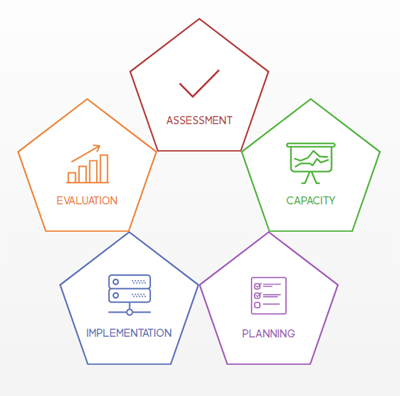The P star system uses the Strategic Prevention Framework (SPF). The SPF was developed by the Center for Substance Abuse Prevention (CSAP), part of the Substance Abuse and Mental Health Services Administration (SAMHSA) of the U.S. Department of Health and Human Services.
The SPF is a process that an organization, initiative, community, or state can follow in order to prevent and reduce the abuse of substances, violence, health-related problems (diabetes, HIV, obesity), homelessness, and discrimination to name a few.
 The SPF is an easy-to-understand 5-step process. It guides an Organization through a logical steps of creating all of the required elements for an organization. The Pinwheel on the right represents those five elements.
The SPF is an easy-to-understand 5-step process. It guides an Organization through a logical steps of creating all of the required elements for an organization. The Pinwheel on the right represents those five elements.
To find out more about each of these elements click the link below and investigate further.
- Assessment. To begin, a working group is assembled that includes representatives of all stakeholders (those who will be affected, directly or indirectly, by the prevention effort) to survey the community and decide on the most pressing issue that can be successfully addressed with the resources available. Assessment consists of three elements:
- Identifying and understanding the population’s needs.
- Determining necessary resources and their availability.
- Assessing community readiness.
When completed several metrics are selected that will be the guide for the Organization. These metrics will help the Organization weigh, track and evaluate the effectiveness of their efforts. The pSTAR system takes these metrics and tracks them for the Organization for use in the Evaluation stage (Step 5 below)
- Capacity. Developing the community’s capacity to engage in a prevention effort involves mobilizing the human, organizational, and financial resources necessary, and then providing the appropriate training and technical assistance so that the community has the knowledge and skills to plan and do the work.
pSTAR allows the Organization to manage all of its resources to better utilize the assets of the community. - Planning. In this phase, a diverse group of stakeholders creates a plan with goals, objectives, and action strategies aimed at meeting the needs of the community. In the course of planning, the group adopts a logic model or framework for action; chooses from among a number of possible evidence-based “best practices;” and determines the costs and other resources that will be needed to implement the plan successfully.
Additionally, the pSTAR Goals Tracker allows you to put in metrics that you have created for yourself or that others have given you. Identifying these allows you to track your work towards your goal on a weekly/monthly/quarterly/yearly basis.
pSTAR allows users to dynamically create the logic model and all the components. pSTAR also allows the logic models components to be tied back to the Assessment metric in order to provide a guide to track the Organizations progress - Implementation. The plan is carried out. Using the Center for Substance Abuse Prevention Reporting System (CSAP 6) or Community Anti-Drug Coalitions of America (CADCA 7) nationally recognized reporting system an Organization can track all their efforts. This includes the Social Media post, the meeting with a City Councilman, or the informational meeting at the local community center.
The pSTAR system allows all work to be collected and then reported and evaluated. The pSTAR system provides 13 primary report types and 20 sub reports so you can accurately track and record your Organizations efforts. - Evaluation. Although listed as the step 5, this actually goes on throughout the process.
The pSTAR system allows you to evaluate in terms of process (Did you actually carry out what you planned did you reach your goal in the time period you planned?), impact (Did your program have the intended effect on the targeted risk and protective factors?), and outcome (Did the program when measured against Assessment and Goals data achieve its overall community-change goals?).
The results of the evaluation are then used to inform the community, grantors, and other institutions and get feedback to adjust the program to make it more effective, and the cycle begins again.
Reference:
The Community Tool Box

